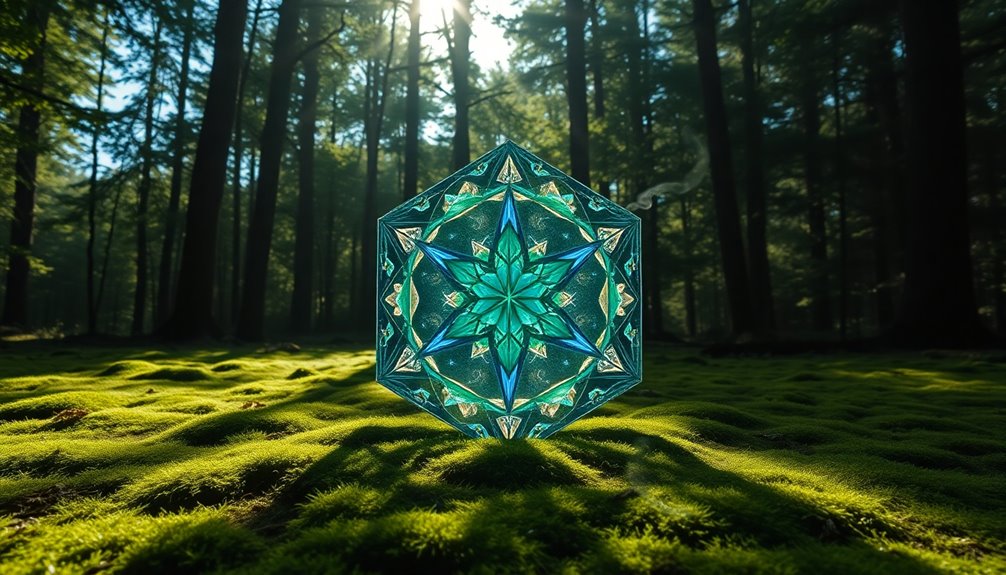Labyrinths serve as meaningful symbols on your spiritual journey, guiding you through meditative walking that fosters inner reflection, growth, and connection with yourself. Their intricate design reflects life’s challenges and moments of clarity, encouraging mindfulness with each twist and turn. Reaching the center becomes a sacred moment of presence, allowing space for insights and healing. If you explore further, you’ll discover how these ancient paths can deepen your understanding of your spiritual path.
Key Takeaways
- Labyrinths symbolize a spiritual journey, guiding inward reflection and personal growth through their intricate, meaningful designs.
- Walking a labyrinth fosters mindfulness, helping individuals quiet thoughts and connect deeply with their inner selves.
- Reaching the center of a labyrinth marks a moment of presence, insight, or spiritual arrival, serving as a sacred space for reflection.
- The twists and turns mirror life’s challenges and clarity, encouraging exploration of one’s inner landscape and self-awareness.
- Engaging in labyrinth walking transforms physical movement into a profound spiritual practice, promoting healing, introspection, and awakening.

Many believe that walking a labyrinth is more than just a physical act; it’s a meaningful journey toward spiritual insight. As you step onto the winding path, you engage in meditative walking—moving slowly and intentionally, allowing your mind to focus inward. This form of walking isn’t hurried; it’s a deliberate practice that helps you quiet your thoughts and connect more deeply with your inner self. With each step, you’re not just following a physical route, but participating in a process filled with symbolic symbolism that mirrors your personal spiritual journey. The labyrinth’s intricate design often reflects life’s complexities, with its twists and turns representing challenges, doubts, and moments of clarity you encounter along your path.
Walking a labyrinth is a meditative journey symbolizing personal spiritual growth and life’s intricate challenges.
As you navigate the labyrinth, you may notice how its shape and structure evoke a sense of unity and interconnectedness. The symbolic symbolism embedded within the labyrinth encourages you to see your spiritual journey as a cohesive whole, rather than a series of disconnected events. The journey inward, marked by the slow, deliberate movement, fosters reflection and mindfulness. When you reach the center, it’s often seen as a moment of spiritual arrival—a point where you can pause, meditate, or simply be present. This pause is crucial, offering you a space to process insights, feelings, or questions that surfaced during your walk.
Walking a labyrinth isn’t about reaching the center quickly; it’s about how you engage with each step along the way. The symbolic symbolism of the design acts as a mirror for your inner life, reminding you that every twist and turn has meaning. You might find that as you follow the path, your thoughts settle, and your mind becomes clearer. The act of meditative walking in this context helps you transcend everyday worries, creating a sacred space for contemplation. It’s in these moments of stillness and focus that you often discover new perspectives or find reassurance in your spiritual quest. Additionally, understanding the symbolic symbolism within the labyrinth can deepen your experience and foster greater insight into your personal growth.
Ultimately, the labyrinth becomes a tool for transformation. The symbolic symbolism woven into its structure guides you through a process of introspection, healing, and awakening. Each walk becomes a personal ritual, a sacred practice that invites you to explore your inner landscape. By embracing meditative walking, you turn a simple physical activity into a profound spiritual experience—one that offers clarity, renewal, and a deeper understanding of your spiritual path.
Frequently Asked Questions
How Do Different Cultures Interpret Labyrinth Symbolism?
Different cultures interpret labyrinth symbolism through their unique cultural symbolism and spiritual meanings. You might see labyrinths as paths to enlightenment, symbols of life’s journey, or representations of spiritual growth. In ancient Greece, they symbolized complex journeys, while in Celtic traditions, they embody spiritual cycles. Across cultures, labyrinths serve as tools for meditation and reflection, emphasizing their universal role in expressing spiritual meanings and guiding personal transformation.
Can Labyrinths Be Used for Meditation or Therapy?
Yes, you can use labyrinths for meditation and therapy. Walking through a labyrinth helps you engage in mindfulness practices, calming your mind and fostering emotional healing. As you follow the winding path, you focus on each step, which promotes clarity and reduces stress. Many find that this active form of meditation enhances self-awareness, making it a powerful tool for emotional well-being and deepening your spiritual journey.
What Are the Historical Origins of Labyrinth Designs?
You might find that labyrinth designs originate from ancient symbolism, reflecting life’s complex journey. Over time, they evolved through architectural innovation, from simple patterns to intricate structures across cultures. Historically, civilizations like the Greeks and Christians embraced these patterns, using them as spiritual tools or protective symbols. This rich architectural evolution reveals a deep human desire to explore inner pathways, making labyrinths timeless symbols of personal and collective transformation.
How Do Personal Experiences Vary When Traversing a Labyrinth?
As you traverse a labyrinth, your personal experiences vary widely, shaping your journey of personal growth and emotional reflection. You might feel a sense of calm or confront inner doubts, depending on your mindset. Some find clarity, while others process unresolved feelings. Each step invites introspection, allowing you to explore emotions deeply and discover new insights about yourself, making every labyrinth walk a unique and transformative experience.
Are There Modern Adaptations of Traditional Labyrinth Practices?
Yes, modern adaptations of traditional labyrinth practices include digital mazes and virtual pathways. You can explore these through smartphone apps, virtual reality experiences, or online platforms that simulate labyrinths. These innovations allow you to engage with the meditative and reflective aspects of labyrinth walking from anywhere, making spiritual exploration accessible in a new, technology-driven way. They offer fresh opportunities for personal growth and mindfulness in the digital age.
Conclusion
As you walk the twists and turns of a labyrinth, you realize that the journey mirrors your spiritual path—filled with challenges, reflections, and moments of clarity. Each step brings you closer to understanding yourself and your purpose. So, next time you face a complex maze, ask yourself: isn’t life itself a labyrinth, guiding us toward growth and enlightenment? Embrace the journey, knowing that every route leads to deeper insight and transformation.










